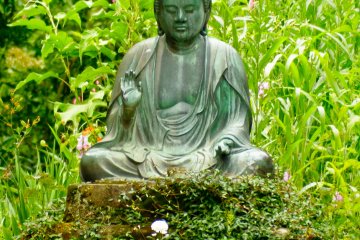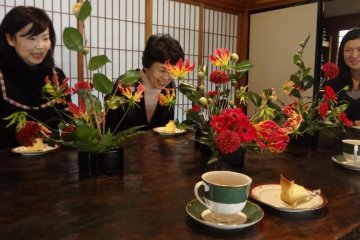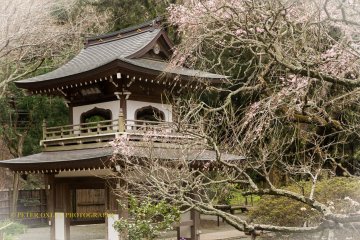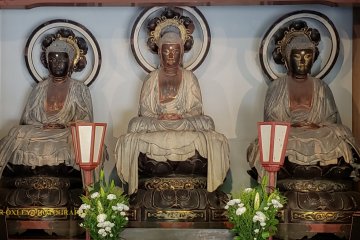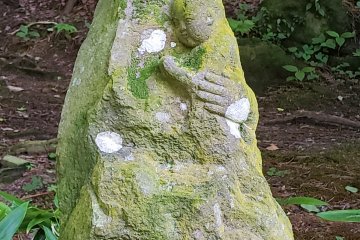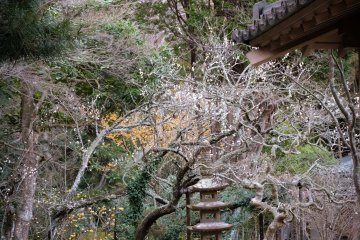Joichiji is a Zen Buddhist temple belonging to the Rinzai sect, established in 1281 by members of the ruling Hojo family on the occasion of the death of the third son, Munemasa, of Hojo Tokiyori, fifth regent of the Kamakura shogunate.
Temple of Pure Wisdom
Joichiji was ranked number four of the five Zen Buddhist mountain temples (gozan) that served as administrative ministries of the Hojo regency which held the reins of power in Japan for some 120 years until 1333. Joichi in English means pure wisdom, hence the temple is also known as the Temple of Pure Wisdom.
At one time, the temple was an extensive complex comprising 11 buildings and housing more than 500 people. Today, it is a much smaller affair, particularly after it was largely decimated, and reconstructed, after the Great Kanto Earthquake of 1923 which emanated from the depths of Sugami Bay on the southern edge of Kamakura.
An Enigma Inside a Riddle
At the entrance to the temple, there is a pond, a stone bridge, and a gate on which are displayed four kanji characters that roughly translate: The treasure you seek may already be in your hand.
The well within the pond is one of the famous 10 wells of Kamakura. It is called the Well of Straight Dew. In olden days, it was renowned as the source of Kamakura's purest drinking water.
But getting back to the inscription, I feel that the message serves as a delightful portent of what the visitor is about to discover as he/she enters a space/time continuum that embraces past, present, and future.
An Unusual Combination of Belfry and Gate
A long flight of moss-covered steps flanked by towering trees filtering the sunlight leads up to the Chinese-style Shoro-mon, a picturesque two-story combination of belfry and gate. The bell, dating back to 1340, is housed on the second floor in this unusual arrangement.
Two remarkable trees stand in the vicinity beyond - a Japanese umbrella pine, allegedly one of the oldest trees in Kamakura, and a white cloud tree that is said to flower for just one week in the year at the beginning of May.
Buddhas That Represent Past, Present, and Future
In front of the trees is the Dongeden, the hall where the main objects of worship are enshrined: three seated statues, Amitabha, Shakyamuni, and Maitreya, representing the Buddha in his past, present, and future guises. These are relics from a time long gone; they date back to the Muromachi Period (1336-1573). The hall is named after a legendary flower that blooms only once in 3,000 years.
Along the periphery of the temple precincts is an elliptical walkway that looks over a wet Zen garden with stone lanterns and pagodas fronting the Shoin, the thatched-roof residential quarters of the temple priests.
Here you will find plum, peach, and sakura in bloom in spring; hydrangea, iris, lotus, and hollyhock in summer; and the red and yellow foliage of autumn. Curiously, there is a statue of Kannon carrying a child in her arms that looks uncannily like the Madonna and Child, prompting some to surmise that it might have been surreptitiously installed by members of the hidden Christian community who were forbidden to practice their faith during the Edo Period (1603-1868).
A Trio of Badgers Showing the Way
Farther along the path, past the old cemetery, you will find a trio of ceramic badgers, looking somewhat the worse for wear as if they had too much to drink, standing somewhere amongst the yagura carved into the hillside, caves that were used as burial chambers and also for daily meditation (zazen) by the temple's monks.
The big badger would seem to be beckoning you to continue walking to a small tunnel cut into the hillside, beyond which presides a stone statue of Hotei, one of the Seven Gods of Good Fortune, the only Buddhist monk among them.
Hotei, a Welcoming God of Good Luck
Hotei is the god of good luck and happiness, the guardian of children, patron of diviners, and - badgers, take note - the god of barmen. If you rub Hotei’s tummy, his forefinger, or his gleaming bald head, it is said that you will be granted amazing good luck.
Hotei is said to represent a real historical person, the Chinese priest, Kaishi, born in the 10th century, who walked around predicting the weather and other people’s futures.
The Dalai Lama once said, There is only now! Yesterday is a memory and tomorrow is unknown. But I am not so sure! I think we can learn from the past, enjoy and appreciate the present, and have high hopes for the future.
Maybe the treasure you seek is already with you! Good luck on your visit!




